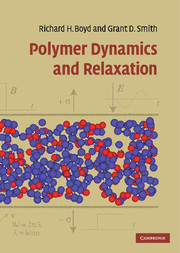Book contents
- Frontmatter
- Contents
- Preface
- Part I Methodology
- 1 Mechanical relaxation
- 2 Dielectric relaxation
- 3 NMR spectroscopy
- 4 Dynamic neutron scattering
- 5 Molecular dynamics (MD) simulations of amorphous polymers
- Part II Amorphous polymers
- Part III Complex systems
- Appendix AI The Rouse model
- Appendix AII Site models for localized relaxation
- Index
- References
2 - Dielectric relaxation
Published online by Cambridge University Press: 10 November 2009
- Frontmatter
- Contents
- Preface
- Part I Methodology
- 1 Mechanical relaxation
- 2 Dielectric relaxation
- 3 NMR spectroscopy
- 4 Dynamic neutron scattering
- 5 Molecular dynamics (MD) simulations of amorphous polymers
- Part II Amorphous polymers
- Part III Complex systems
- Appendix AI The Rouse model
- Appendix AII Site models for localized relaxation
- Index
- References
Summary
Materials in which the response to an applied electric field is primarily due to transient displacement of charges rather than the steady state migration of charge (i.e., DC conductance) are generally described as insulators and classified as dielectrics. Most polymeric materials can be classified as dielectrics under the normal conditions of use.
The reasons for considering the electrical response are three-fold. The first reason is the obvious one that there may well be interest in the application of a polymeric material as a dielectric and hence those properties need to be studied. The second reason, perhaps the most important in terms of the actual number of studies that have been carried out, is that dielectric property measurements are often a very convenient way to characterize the time dependent behavior of polymeric materials. That is, dielectric response often shows the presence of relaxation regions in the same time–temperature region and due to the same underlying molecular mechanism as, for example, mechanical relaxation. The dielectric measurements, however, may often be more conveniently carried out. The third reason is that, the interpretation of dielectric measurements in terms of molecular parameters is usually more straightforward than in the mechanical case.
The preceding chapter developed methods for describing the time dependent response of stress to imposed strain (relaxation modulus) or of strain to imposed stress (retarded compliance). There is an electrical analogy to this mechanical response.
- Type
- Chapter
- Information
- Polymer Dynamics and Relaxation , pp. 27 - 43Publisher: Cambridge University PressPrint publication year: 2007
References
- 1
- Cited by

